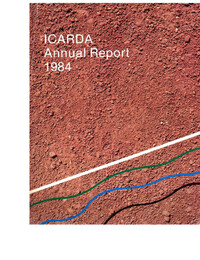ICARDA Annual Report 1984

Authors:
1983/84 was one of the driest years on record (210 mm at Tel Hadya, most before November), leaving crops without rain during growth. Severe drought hit both research trials and farmers’ fields.
1983/84 ICARDA Report major highlights:
1. Drought highlighted the need for breeding stress-tolerant crops.
2. Barley: Rihane Sister lines, ER/Apam, Harmal, Soulara performed well.
3. Durum wheat: Sebou and Korifla outyielded local Haurani.
4. Bread wheat: Two lines (Flk ‘S’/Hork ‘S’, HD 2206/Hork ‘S’) advanced for multi-country testing.
5. Legumes: Faba beans and lentils suffered yield losses, but ICARDA lentil genotypes gave 25% higher yields in Syrian trials. Lentil straw became vital livestock feed.
6. Severe feed shortages; many farmers grazed barley fields early or sold livestock.
7. Fertilizer use (especially phosphate) improved barley yields even under 200 mm rainfall, proving profitable when feed prices rose.
8. Five new barley, six durum wheat, and four bread wheat varieties identified for release in multiple countries.
9. Chickpea and lentil varieties released in Cyprus and Ethiopia.
10. Stronger ties with Syria, Morocco, Tunisia, Sudan, Egypt, Pakistan, and others.
11. Expansion of the Nile Valley Project (Egypt, Sudan, Ethiopia) with farmer demonstrations showing yield increases of 85%.
12. New agreements launched with Pakistan (MART project) and progress with Turkey, Iran, Iraq, and Yemen.
13. Training programs expanded; greater use of Arabic publications for regional researchers and policymakers.
14. Construction of new labs and training buildings at Tel Hadya progressed well.
